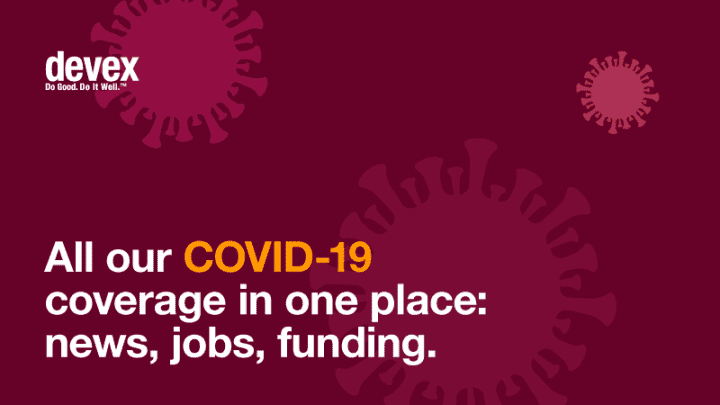Blind spots: What COVID-19 revealed about global development’s biggest gaps

Before COVID-19 took hold as a pandemic one year ago, global health experts had long warned that such an event was inevitable and that the world had better prepare. While some elements of preparedness might have been obvious, the coronavirus has also shed light on critical pieces of the global health and development landscapes that were harder to see before.
Sign up for Devex CheckUp
The weekly must-read newsletter for exclusive global health news and insider insights.
“I hope that it is a wake-up call for world leaders, for everybody to see how vulnerable we are,” said Dr. Khuất Thị Hải Oanh, executive director at the Center for Supporting Community Development Initiatives in Vietnam.
As health and development leaders try to ensure the lessons of COVID-19 inform how institutions are organized and reformed, how future investments are prioritized, and how policies can better protect people against the multiple impacts of infectious disease, they are taking stock of what caught them off guard.
Devex spoke to health and development leaders about what has surprised them in how the pandemic has unfolded. They highlighted the importance of local expertise — and manufacturing — for global health, the power of politics and social media to influence information and behavior, the persistent gap between technology and equity, and the disparate impacts of public health measures on vulnerable people.
One year after the World Health Organization declared COVID-19 a pandemic, its damage is both measurable and immeasurable: nearly 120 million global cases of COVID-19, with more than 2.6 million deaths and counting.
“What we saw with COVID so very quickly was that the structural realities of our underlying inequalities in health care were replicated again,” said Chris Beyrer, a professor of public health and human rights at the Johns Hopkins Bloomberg School of Public Health.
“It was with dizzying speed that this virus exploited those vulnerabilities,” he said.
Local networks
Dr. Paul Wekesa is CEO at the Centre for Health Solutions – Kenya, a Nairobi-based nonprofit organization that works on HIV, tuberculosis, and health systems programs alongside international donors and Kenya’s Ministry of Health.
“The reality is that when the pandemic hit, a lot of [international] experts went back home,” Wekesa said.
Wekesa said he hopes the pandemic has demonstrated the value of investing in local institutions — an area where Kenya still has significant gaps, he noted — so that local leaders can emerge as the network for coordination with international expertise.
“I think the pandemic becomes a big lesson in terms of how do you grow local manufacturing for global health.”
— Dr. Paul Wekesa, CEO, Centre for Health Solutions – Kenya
Wekesa and his colleagues did not feel resentment toward international donor representatives and experts when they returned to their own countries, he said, because their investments have helped to build a base of local expertise.
“As local experts, we are actually grateful that there has been supportive policy to build local expertise in countries, such that when the pandemic hit, we realized that then this becomes a resource … upon which to base the responses and to enforce some of the responses in our spheres of influence,” Wekesa said.
The pandemic also severed international supply chains at a moment of unprecedented demand for protective equipment such as masks. For Kenya, which depends heavily on imports, surgical masks became “a hot commodity” that was out of reach for many people until the country’s ability to manufacture them caught up.
“There was a lot of repurposing of local manufacturing, such that there was production of some of these essential tools for prevention locally, and that really had a big impact on pricing and on scale,” Wekesa said.
“I think the pandemic becomes a big lesson in terms of how do you grow local manufacturing for global health,” he said.
These commodities were lower priorities for Kenya’s manufacturing sector before, but the pandemic has shown that there is both a market and a clear public need for “proximal access to essential equipment for pandemic response in the future,” he said.
Seeing the mass uptake of these basic health commodities has also opened people’s eyes to the possibilities for large-scale preventive responses to other infectious diseases, especially respiratory diseases, according to Wekesa.
“Nobody had seen the scale to which adoption would occur,” he said.
The misinformation war
While scientists raced to decipher the virus and find defenses against it, they found themselves simultaneously battling a political context that made it difficult to communicate accurate information. The information they tried to put out into the world ran up against a swell of rumor, conspiracy, misinformation, and politically motivated messaging.
“I never expected that politics would be so divided that even science becomes questioned. … I never dreamed that nobody would listen to science,” said Ali Mokdad, a professor of health metrics sciences at the Institute for Health Metrics and Evaluation in Seattle.
After the pandemic: How will COVID-19 transform global health and development?
We asked 21 leaders and big thinkers to share their insights and predictions for how the COVID-19 crisis might transform the fields of global health and development. Here is what they said.
Health experts were caught off guard by the virality of bad information — the fact that large numbers of people might be more compelled to believe false and sensational claims than those backed by scientific evidence. That was a challenge for scientists and organizations that have not typically been the savviest social media influencers, Mokdad said.
Get development’s most important headlines in your inbox every day.
Thanks for subscribing!
“You have somebody who has a crazy idea, but they know the system,” he said.
Mokdad was particularly struck by the reach of anti-vaccination — or “anti-vax” — activists, even though the information they were spreading was inaccurate.
“Some of them were funded by governments. We didn’t know that,” Mokdad said. “We never expected an organized, powerful, well-funded machinery.”
Mokdad said he expects that one of the biggest lessons for global health organizations will relate to the importance of global health communication — or what some refer to as “translation.”
“That’s the biggest one — we want to bring everybody to the table. We need to listen to everybody, and we need to speak to everybody in their own languages,” Mokdad said.
Macro vs. micro
Vietnam reported its first case of COVID-19 on Jan. 23, 2020. While many other countries have seen their case counts skyrocket since then, the Southeast Asian nation has recorded just over 2,500 cases in total, with new daily infections currently in the single digits. The country’s success has been the result of strict public health measures, including travel restrictions between provinces and aggressive lockdowns.
Those measures have come with their own costs, according to Oanh at the Center for Supporting Community Development Initiatives.
“We don’t feel the impact of the COVID as a medical problem. We feel the impact of the response to COVID,” she said.
The government was keenly aware that its public health measures would come with high economic costs, but its attention was often focused on “the economic impact at the macro level” more than it was on the particularly severe implications for Vietnam’s most vulnerable, Oanh said.
“Many people didn’t think about it at the beginning, because the people who live on salary and the government officials who still receive the full salary — they may not be aware unless they work very closely on this issue. They may not be aware that their people were severely affected,” Oanh said.
The pandemic has reinforced the message of the Sustainable Development Goals 2030 agenda, which calls on countries to ensure they leave no one behind in their pursuit of development, she added.
“If you can reduce that vulnerability, provide security for people, then they will be safer in the future … [and] you don’t have to compromise too much the broader development future for a public health issue,” Oanh said.
“Here we are in the middle of a pandemic, and it’s all the evidence you need about how we have not come to terms with the fundamental inequalities here.”
— Chris Beyrer, professor of public health and human rights, Johns Hopkins Bloomberg School of Public Health
History repeats
Not all of the surprises were bad. Few health experts predicted that within one year, countries would be distributing multiple highly effective vaccines against a previously unidentified virus.
“That has not been my experience with many other viral diseases,” said Beyrer from Johns Hopkins.
That “spectacular” achievement in research and development has given rise to what is now “one of the great global health challenges” — the equitable global rollout of the vaccine — Beyrer said.
Far from finding itself in uncharted waters, however, the global health community is experiencing déjà vu. A handful of wealthy countries have pre-purchased most of the available vaccine doses, while the majority of others have yet to begin vaccinating even high-risk populations.
Two decades ago, when the HIV epidemic was at its worst, health experts referred to the phenomenon as “AIDS exceptionalism,” Beyrer said.
“Ninety-five percent of people were living in countries where there wasn’t any antiviral therapy, and 5% were living in countries where there was,” he said.
Health activists took on some of the structural impediments to global distribution of HIV therapies, “but that didn’t happen for many other many other diseases and many other really lifesaving tools,” Beyrer said.
In the absence of comprehensive policies such as universal health coverage, global health efforts have resorted to “workarounds” and ad hoc measures to help fill in access gaps. The COVAX Facility for global COVID-19 vaccine distribution is a current example, Beyrer said.
“We shouldn’t be surprised, given the way R&D is structured, that this is happening again,” he said.
“Here we are in the middle of a pandemic, and it’s all the evidence you need about how we have not come to terms with the fundamental inequalities here,” he added.

Printing articles to share with others is a breach of our terms and conditions and copyright policy. Please use the sharing options on the left side of the article. Devex Pro subscribers may share up to 10 articles per month using the Pro share tool ( ).


